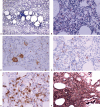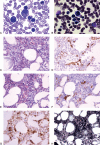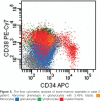Successful eltrombopag treatment of severe refractory thrombocytopenia in chronic myelomonocytic leukemia: Two cases reports: A CARE-compliant article
- PMID: 29069007
- PMCID: PMC5671840
- DOI: 10.1097/MD.0000000000008337
Successful eltrombopag treatment of severe refractory thrombocytopenia in chronic myelomonocytic leukemia: Two cases reports: A CARE-compliant article
Abstract
Rationale: Thrombocytopenia in chronic myelomonocytic leukemia (CMML) is usually attributed to impaired marrow production resulting from cytotoxic drug use or CMML itself ("CMML-induced thrombocytopenia"). In very rare cases, immune thrombocytopenia (ITP) can be a complication of CMML ("CMML-associated ITP"). However, treatment of severe thrombocytopenia in patients with CMML is still a challenge.
Patient concerns: Case 1 was a 61-year-old female patient admitted to our hospital because of skin petechiae and purpura for 6 days. She had increased monocyte cell count (1.82 × 10/L), markedly decreased platelet count (2 × 10/L), hypercellularity of the megakaryocyte lineage with many immature megakaryocytes, and ZRSR2(zinc finger CCCH-type, RNA binding motif and serine/arginine rich 2) mutation. She failed to the treatment of corticosteroids, intravenous immunoglobulin (IVIg), TPO (thrombopoietin), and cyclosporin A (CsA). Case 2 was a 72-year-old female patient with thrombocytosis and monocytosis for 4 years, and thrombocytopenia for 6 months. After 10 courses of decitabine therapy, she had a persistent severe thrombocytopenia and decreased number of megakaryocytes, TET2 (tet methylcytosine dioxygenase 2) and SRSF2 (serine and arginine rich splicing factor 2) mutations were detected. She was dependent on platelet transfusion.
Diagnoses: Case 1 was diagnosed as CMML-associated ITP, and case 2 as CMML with decitabine therapy-induced thrombocytopenia.
Interventions: Both patients were treated with eltrombopag.
Outcomes: In both patients, the platelet counts returned to the normal within 1 week after eltrombopag therapy. The platelet count in case 1 patient remained stable at 141-200 × 10/L for 20 months with stopping therapy for 3 months. In case 2 patient, eltrombopag was stopped 1 month later. Her platelet count decreased to 41 × 10/L, but was stable at ∼30 × 10/L for 3 months with platelet transfusion independency for 12 months. Both patients had no adverse effects with eltrombopag.
Lessons: CMML-associated ITP is very rare and easily misdiagnosed. To the best of our knowledge, case 1 is the first reported case of the successful treatment of CMML-associated ITP with eltrombopag. Both CMML-associated ITP and decitabine therapy-induced thrombocytopenia in these 2 patients were highly sensitive and safe to eltrombopag therapy.
Conflict of interest statement
The authors report no conflicts of interest.
Figures






References
-
- Bennett JM, Catovsky D, Daniel MT, et al. The chronic myeloid leukemia: guidelines for distinguishing chronic granulocytic, atypical chronic myeloid, and chronic myelomonocytic leukemia. Proposals by the French-American-British Cooperative Leukemia Group. Br J Haematol 1994;87:746–54. - PubMed
-
- Vardiman JW, Thiele J, Arber DA, et al. The 2008 revision of the World Health Organization (WHO) classification of myeloid neoplasms and acute leukemia: rationale and important changes. Blood 2009;114:937–51. - PubMed
-
- Arber DA, Orazi A, Hasserjian R, et al. The 2016 revision to the World Health Organization classification of myeloid neoplasms and acute leukemia. Blood 2016;127:2391–405. - PubMed
-
- Itzkson R, Fenaux P, Solary E. Chronic myelomonocytic leukemia: myelodysplastic or myeloproliferative? Best Pract Res Clin Haematol 2013;26:387–400. - PubMed
-
- Hadjadj J, Michel M, Chauveheid MP, et al. Immune thrombocytopenia in chronic myelomonocytic leukemia. Eur J Haematol 2014;93:521–6. - PubMed
Publication types
MeSH terms
Substances
LinkOut - more resources
Full Text Sources
Other Literature Sources

